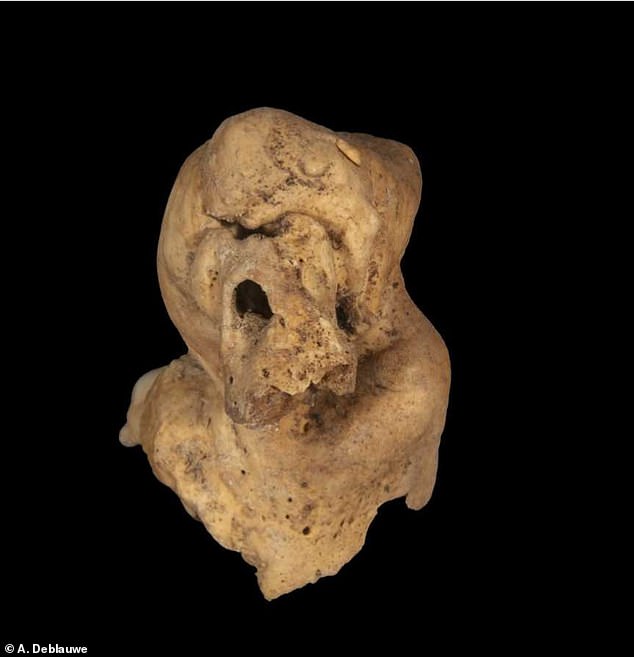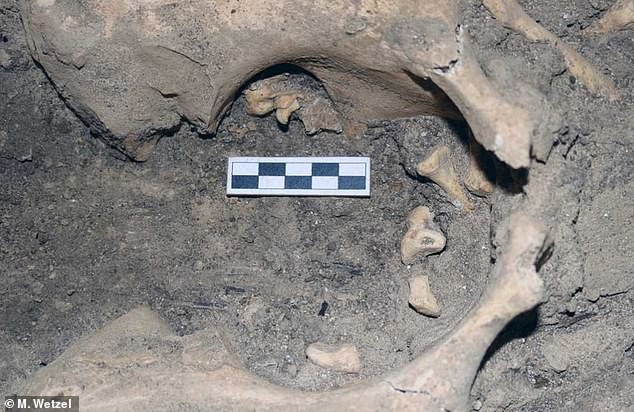Tumor with TEETH is discovered in Egypt among remains of ancient woman who died more than 3,000 years ago
>
- An ovarian tumor found in a woman’s remains included two deformed teeth
- This is called a teratoma, which contains different layers of tissue such as hair and muscle
- Read more: 500-year-old ovarian tumor with five teeth found in Portugal
A dental tumor was discovered in Egypt.
The ovarian mass, about the size of a nickel, was found among the remains of a woman who died more than 3,000 years ago.
The woman, who was between 18 and 21 years old at death, was discovered in the non-elite Amarna cemetery, wrapped in a plant-fiber mat and decorated with gold beads and jewellery.
The growth, measuring three centimeters by two centimeters long, was lodged in the pelvic bone, where researchers discovered teeth with distinctive crowns covered in enamel.
It is the oldest known example of a teratoma, a tumor composed of various tissues such as muscle, hair, bone or teeth, discovered by archaeologists, with previous cases discovered in Europe and Peru.
The growth, measuring three centimeters by two centimeters long, was lodged in the pelvic bone, where researchers discovered teeth with distinctive crowns covered in enamel.
Teratomas are very rare, and there are no reliable figures on the number of cases, but modern women still suffer from them. It occurs when germ cells transform into different cells.
Amarna is a site on the east bank of the Nile River, home to at least 1,000 tombs in cemeteries for non-elite citizens in the ancient city of Akhetaten.
The Amarna Tombs Investigation Project began in 2005, and is currently led by Anna Stevens of the University of Cambridge and Gretchen Dabbs of Southern Illinois University, who discovered the woman’s remains.
The team determined the sex of the skeleton based on the shape of the pelvis and metric analysis of the humeral head and femoral head.
Her age was estimated using a combination of assessments based on how her teeth developed in the dental arch.
Together with the covered growth team, archaeologists A golden ring was also found around the woman’s finger bearing the image of Bes, the god of fertility.
They speculate that the ovarian tumor may have hindered her ability to conceive.

The photo shows the reverse side of the tumor, opposite the teeth, and shows the mummified mass that had been extracted from the woman’s pelvic bone.

The team determined the sex of the skeleton based on the shape of the pelvis and metric analysis of the humeral and femoral heads.
“The presence of a gold ring decorated with the god Bes on the left hand of individual 3051 (the designation given to women), and perhaps the placement of the hand and ring near the mass, may indicate that the teratoma was not asymptomatic,” the study published in the journal “Individual 3051 was trying to treat.” Call Bess to protect her from pain or other symptoms, or to assist her in her attempts to become pregnant and give birth.” Direct Science.
Debs said Live sciences That the woman was likely someone’s wife and “there was no doubt that she was working,” unlike most others her age who were working on statewide construction projects, brewing beer, or tending to home gardens and livestock.
Another case of teratoma was detected in Lisbon, Portugal, but this ovarian tumor was twice the size of at least five malformed teeth.
The tumor was discovered in a cemetery in the Carmo Church and Monastery in Lisbon, where 42 burials were excavated in 2010 and 2011.
Allison Foley, a bioarchaeologist at the College of Charleston in South Carolina who was not involved in the study, told Live Science that the ancient Egyptian woman’s tumor is of great interest because “teratomas are rarely identified archaeologically.”
“The presence of the Bess Ring, its location and its potential symbolic significance as a symbol of protection and fertility is particularly fascinating and evocative,” Foley said.
(tags for translation)dailymail
